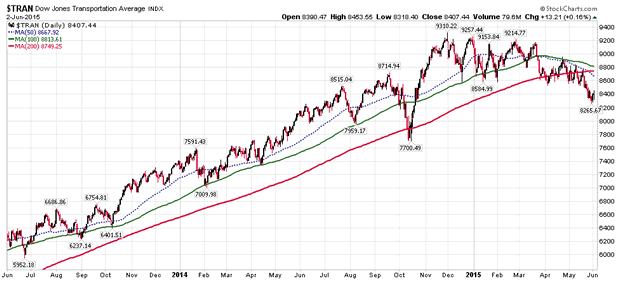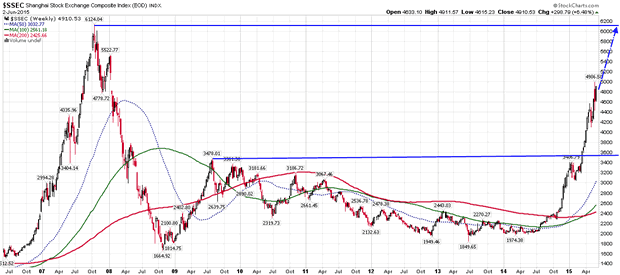Stock Markets 2015 - Don't Fight The Fed!
Stock-Markets / Stock Markets 2015 Jun 16, 2015 - 01:08 PM GMTBy: Puru_Saxena
 BIG PICTURE - At the beginning of the year, market participants were expecting the Federal Reserve to raise interest rates during the summer months. This widely anticipated monetary tightening prompted investors to become cautious which halted the primary advance and brought about a multi-month consolidation on Wall Street.
BIG PICTURE - At the beginning of the year, market participants were expecting the Federal Reserve to raise interest rates during the summer months. This widely anticipated monetary tightening prompted investors to become cautious which halted the primary advance and brought about a multi-month consolidation on Wall Street.
It is no secret that since mid-December, the environment on Wall Street has been quite volatile; nonetheless, despite the wild swings, the major US indices have essentially gone nowhere.
If you review Figure 1, you will observe that during December, the S&P500 Index peaked at 2,093.55 and at the time of writing, it is sitting at 2,111.73. Put simply, over the past six months, the bellwether index has appreciated by less than one percent!
In addition to the S&P500 Index, the Dow Jones Industrial Average and the NASDAQ Composite have also barely moved over the past 6 months and this sideways trading range denotes a keen tussle between the bulls and the bears.
Although the broad stock market in the US has not done much since December, it is encouraging to note that all the major indices are currently trading above the key moving averages. More importantly, during the ongoing consolidation, the small-caps and growth stocks are outperforming the broad market and this is another positive omen.
In our view, if a primary bear-market was imminent, institutional investors would be fleeing the cyclical growth stocks and parking their capital in the more defensive large-cap companies. So far, this has not happened and this relative strength in the small-caps implies that we are nowhere near the start of a primary downtrend in common stocks.
Figure 1: S&P500 Index (daily chart)

Source: www.stockcharts.com
In terms of technical data, it is encouraging to note that the NYSE Advance/Decline Line recently climbed to a record high and it is now trading just beneath that level. In other words, the market's breadth remains strong and at least so far, we have not witnessed any negative divergence between the NYSE Advance/Decline Line and the major US indices. Elsewhere, the KBW Bank Index has climbed to a multi-year high and in our opinion, this relative strength in the financials bodes well for the broad stock market. Last but not least, during the ongoing sideways grind, the number of NYSE 52-week highs has remained consistently above the number of NYSE 52-week lows and this development also suggests that we are still in a primary uptrend.
As far as the macro-economic scenario is concerned, there can be no doubt that the world is passing through a low growth, disinflationary environment. After all, private-sector credit growth is still pretty weak and this is translating into sluggish business activity throughout the developed world.
Looking at specific regions, on the back of Bank of Japan's and the European Central Bank's quantitative easing initiatives, both Japan and the Eurozone saw mild economic expansion during the first quarter of this year. However, after the withdrawal of the Federal Reserve's 'stimulus', business activity in the US is struggling yet again and during the first quarter of this year, the world's largest economy contracted by almost 1% (Figure 2)!
Figure 2: US GDP (% change, seasonally adjusted)

Source: St. Louis Fed
Given the fact that the US saw a negative GDP print in the first quarter and inflation remains well contained, we are of the view that the Federal Reserve will not raise its Fed Funds Rate anytime soon. In fact, we suspect that the Federal Reserve will stay on hold until the end of this year and under the most hawkish scenario, it will only start to raise interest rates in baby steps (25bps at a time) sometime next year.
Look. From the outset, the Federal Reserve has made it very clear that its policy decisions will be 'data dependent' and it will leave interest rates at extremely low levels for the foreseeable future.
Although there are no guarantees in this business, we are of the view that if the Federal Reserve 'walks its talk', then the Fed Funds Rate will stay near its historic low for as far as the eye can see and this in turn, will be favourable for the stock market.
Make no mistake, when it comes to investing, the risk free rate of return determines the value of each asset and if cash continues to yield next to nothing for several years, then today's stock market may prove to be quite cheap!
Now that we have covered some of the favourable factors which support our primary uptrend hypothesis, we wish to discuss a couple of recent developments which need to be monitored closely.
First on our list of 'red flags' is the recent weakness and negative divergence in the Dow Jones Transportation Average. As you can see from Figure 3, this index peaked late last year and after a multi-month grind, it has now sliced through the key moving averages. More importantly, the 50-day moving average (blue dotted line on the chart) has dipped below the 200-day moving average which also seems to be rolling over.
Figure 3: Dow Jones Transportation Average (daily chart)

Source: www.stockcharts.com
Before you panic and head for the hills, you may want to note that back in 2011 and 2012, the Dow Jones Transportation Average also traded beneath the key moving averages for several months; so the ongoing weakness may well resolve to the upside.
In any event, given the fact that the transportation stocks are closely tied to the economy, their recent weakness is a cause for concern. At this stage, we do not know whether last year's peak marked the top for the entire bull-market; but if the primary uptrend on Wall Street is still intact (our view), the Dow Jones Transportation Average will need to reverse course and outperform the broad market.
Next on our list of 'red flags' is the ongoing distribution in some of the leading growth stocks of this bull-market. In our view, the leading growth stocks represent the generals of the army and when they are shot down, one should pay attention!
Fortunately for the bulls, only some of this cycle's leaders are currently showing signs of heavy distribution (Baidu, Buffalo Wild Wings, Chipotle Mexican Grill, Lululemon and Tesla to name a few); whereas many other growth stocks are still powering ahead (Apple, Mastercard, Netflix, Nike, Starbucks, Tencent and Visa etc.).
Bearing in mind that we are now dealing with a mature bull-market, it is normal that not all stocks are participating in the festivities. After all, weakening stock market breadth is a classic sign of an ageing bull-market and this divergent price action implies that one needs to be extremely disciplined and hold only the strongest stocks. For our part, we are carefully monitoring all the holdings in our managed portfolios and promptly pruning out the weak securities.
As far as sector analysis is concerned, we are seeing persistent strength in apparel, asset managers, auto dealers, auto parts manufacturers, banks, biotechnology, brokers/dealers, credit cards, footwear, healthcare, industrials, insurance, logistics, retail and restaurant stocks.
On the other side of the ledger, transportation stocks are looking weak and unless they show signs of strength, our readers should avoid this sector. Elsewhere, commodities, energy and precious metals stocks are also struggling and this is not the time to be exposed to these securities. Finally, the Macau casino stocks are still in relentless downtrends and this is not the time to catch these falling knives!
In terms of geographical areas, we remain optimistic about equities in the developed world (Europe, Japan and the US). Although the stock markets of Europe and the US have been caught in a trading range for several weeks, we are of the view that this period of consolidation will soon end with a breakout to the upside.
Elsewhere, we continue to recommend exposure to China, Hong Kong, India and Taiwan. Although the Indian stock market has pulled back somewhat since early March, we view this as a routine consolidation within the context of a primary uptrend. Thus, once the ongoing pullback has run its course, India's stock market should commence its new up leg.
Over in China, it appears as though the brief consolidation phase is now behind us and a renewed rise is underway. As you can see from Figure 4, the Shanghai Composite Index recently surpassed its April high and it is currently sitting just beneath the 5,000 level.
Although the mob can do anything, we believe that the Shanghai Composite Index will now levitate towards its all-time high recorded in October 2007 and once it overcomes that hurdle, we will witness a truly epic mania in the world's most volatile stock market! Accordingly, our Discretionary Equity and Discretionary Fund Portfolios are currently overweight China's A-shares.
Figure 4: Shanghai Composite Index (weekly chart)

Source: www.stockcharts.com
In summary, with two prominent central banks engaged in an unprecedented bond buying program and with the Federal Reserve on 'hold', the path of least resistance for the stock market remains up. Accordingly, for the time being, our readers are advised to stay fully invested in our preferred geographical areas and sectors. For our part, we have invested our Discretionary Equity Portfolio and Discretionary Fund Portfolio in the strongest areas of the market and are pleased that since inception, both these strategies have outperformed the MSCI AC World Index by a wide margin.
Puru Saxena publishes Money Matters, a monthly economic report, which highlights extraordinary investment opportunities in all major markets. In addition to the monthly report, subscribers also receive “Weekly Updates” covering the recent market action. Money Matters is available by subscription from www.purusaxena.com.
Puru Saxena
Website – www.purusaxena.com
Puru Saxena is the founder of Puru Saxena Wealth Management, his Hong Kong based firm which manages investment portfolios for individuals and corporate clients. He is a highly showcased investment manager and a regular guest on CNN, BBC World, CNBC, Bloomberg, NDTV and various radio programs.
Copyright © 2005-2015 Puru Saxena Limited. All rights reserved.
Disclaimer: The above is a matter of opinion provided for general information purposes only and is not intended as investment advice. Information and analysis above are derived from sources and utilising methods believed to be reliable, but we cannot accept responsibility for any losses you may incur as a result of this analysis. Individuals should consult with their personal financial advisors.© 2005-2022 http://www.MarketOracle.co.uk - The Market Oracle is a FREE Daily Financial Markets Analysis & Forecasting online publication.



